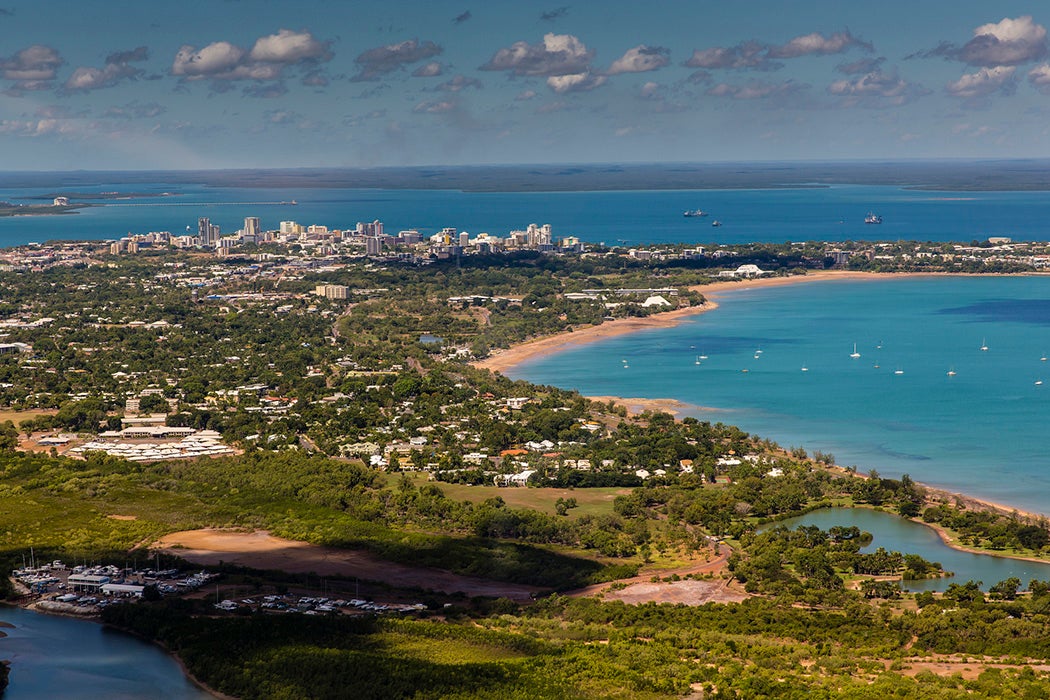“Some day it may be civilized and spoilt,” wrote Australian poet Banjo Paterson in 1898. “But up to the present it has triumphantly overthrown all who have tried to improve it.”
Paterson was referring to the Northern Territory, the gargantuan, sparsely populated tract of bush that spreads from the cynosure of the heat-blasted outback to its northerly tropics. Some call it Australia’s last frontier. Darwin, with its population of a mere 130,000, is its sole urban hub of any substantial size.
Closer to Asia than the cities of southern Australia, Darwin is named after the naturalist and founder of the theory of evolution who, contrary to popular belief, never actually traveled to the region. The HMS Beagle, made famous for having Charles Darwin as its most revered passenger, did sail to the bay in 1839, however, which is when Lt. John Lort Stokes named the harbor Port Darwin after his famous, former ship- and cabin-mate. In 1871, gold was discovered at nearby Pine Creek, but the nascent town itself was only given the name Darwin, to match the port, in 1911.
Writing 150 years after the Beagle’s passage, George Brown, then curator of the Darwin Botanic Garden, explores how early settlers saw the economic potential of the lush, tropical landscape. Dr. Maurice Holtze founded the town’s still extant botanical gardens in the 1880s, claiming that 400 species of “economic plants” (including bananas, sugarcane, and pineapple) had been established in the gardens. Future trading prospects must have seemed bright.
The boom times, fed by gold, were abruptly ended by the Second World War when the town played a crucial role in the Pacific War Theater. In his review of Tom Lewis’s book, Eagles Over Darwin: American Airmen Defending Northern Australia in 1942, Gary Connor notes that Darwin became “the core of the wall erected to stop the Japanese advance and prevent the invasion of Australia.”
As well as suffering substantial damage from Japanese bombs, Darwin has also had to deal with the ravages of natural phenomena. Sociologist J. Eugene Haas, economist Harold C. Cochrane, and disaster relief administrator Donald G. Eddy describe the devastation wreaked by Cyclone Tracy, which hit the town on Christmas morning, 1974.
“Mattresses became the most valuable property that night. They were about the only moveable source of protection from flying debris,” they write, detailing the extraordinary, if temporary, evacuation of more than 23,000 people from the city.
Today, Darwin is perhaps best known not just for its remoteness, but for its staggering stretches of pure, soft sand, beloved by locals and visitors alike. In his lavish 2012 book on Australia’s best beaches, Brad Farmer describes Darwin’s Mindil Beach as “a multicultural feast of freewheeling characters under a canopy of coconut palms.” Though the beach itself is patrolled by the occasional crocodile (and yes, lifeguards), the real draw at Mindil is the market that backs the kilometer-long stretch of sand.
Mindil Beach is also known for its longstanding connection with the Beer Can Regatta, which takes its name from the boats constructed of empty aluminum cans just for the festival. The Beer Can Regatta highlights some “fundamental features of [Northern] Territory life,” writes Peter G. Mewett in his anthropological study of the event. He argues that it’s
associated with working men and in particular with the characteristics imputed to the “real man” and the part he is purported to play—in distinction to both women and effete male—in the “development” of the Territory, which is projected as Australia’s last frontier.
Mewett was writing in 1984. The Beer Can Regatta is still beer-forward today, but it also includes activities for children.
Weekly Newsletter
While Darwin continues to pull in visitors keen for some creature comforts and urban respite after their travels in the wilds of the Northern Territory, there are still substantial issues facing many of the town’s people. A report in a 2014 issue of Urban Studies penned by Cameron Parsell and Rhonda Phillips states the between 95 and 99 percent of homeless sleepers in the city are Australian Indigenous people. The report argues against the “institutionalised racism that normalises such inequitable distribution of resources and the enactment of legislation exclusively towards a cultural group that underpin rough sleeping.”
Featuring tropical sands, turbulent storms and transient sleepers, the social and natural evolution of Darwin appears to be, simultaneously, just as wondrous, chaotic and diffuse as the theory created by the man after whom the city is named.
Teaching Tips
Search the 19th Century British Pamphlets Collection for historical materials related to the colonization of Australia. A few examples:
- Sketch of a proposal for colonizing Australasia, &c., &c., &c. (1829)
- Outline of a system of legislation, for securing protection to the aboriginal inhabitants of all the countries colonized by Great Britain (1840)
- Stray suggestions on colonization (1849)
- A chapter on the present condition and prospects of the Australian colonies (1857)
- Colonization of North Australia (1863)
The same collection contains botanical reports, natural resource bulletins, and much more.







